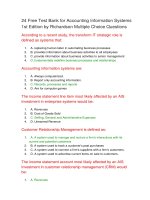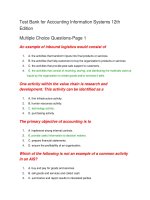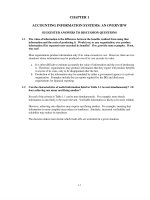Solution manual accounting information systems 12th edition by romney and steinbart CH04
Bạn đang xem bản rút gọn của tài liệu. Xem và tải ngay bản đầy đủ của tài liệu tại đây (1.01 MB, 41 trang )
Find more on www.downloadslide.com
CHAPTER 4
RELATIONAL DATABASES
SUGGESTED ANSWERS TO DISCUSSION QUESTIONS
4.1
Contrast the logical and the physical view of data and discuss why separate views are
necessary in database applications. Describe which perspective is most useful for each of the
following employees: a programmer, a manager, and an internal auditor. How will
understanding logical data structures assist you when designing and using database systems?
Databases are possible because of their database management system (DBMS). As shown in Figure
4.2, the DBMS is a software program that sits between the actual data stored in the system and the
application programs that use the data. As shown in Figure 4.4, this allows users to separate the
way they view the data (called the logical view) from the way the data is actually stored (the
physical view). The DBMS interprets the users' requests and retrieves, manipulates, or stores the
data as needed. The two distinct views separate the applications from the physical information,
providing increased flexibility in applications, improved data security, and ease of use.
In a database system, the manager will rarely need to understand or be familiar with the physical
view of the data. Nor, in most instances, will the internal auditor and the programmer as most
everything they do involves the logical view of the data.
If accountants understand logical data structures and the logical view of the data, they are better
able to manage, use, and audit a database and its data.
4.2
The relational data model represents data as being stored in tables. Spreadsheets are another
tool that accountants use to employ a tabular representation of data. What are some
similarities and differences in the way these tools use tables? How might an accountant’s
familiarity with the tabular representation of spreadsheets facilitate or hinder learning how
to use a relational DBMS?
A major difference between spreadsheets and databases is that spreadsheets are designed primarily
to handle numeric data, whereas databases can handle both text and numbers. Consequently, the
query and sorting capabilities of spreadsheets are much more limited than what can be
accomplished with a DBMS that has a good query language.
Accountants’ familiarity with spreadsheets might hinder their ability to design and use relational
DBMS because many links in spreadsheets are preprogrammed and designed in, whereas a welldesigned relational database is designed to facilitate ad-hoc queries.
Accountants’ familiarity with spreadsheets sometimes leads them to use a spreadsheet for a task
that a database could handle much better. Over the years, the Journal of Accountancy has
published a number of very good articles on how to use databases and when to use databases and
when to use spreadsheets. These articles can be found on the Journal’s website:
/>
Find more on www.downloadslide.com
Ch. 4: Relational Databases
4.3
Some people believe database technology may eliminate the need for double-entry accounting.
This creates three possibilities: (1) the double-entry model will be abandoned; (2) the doubleentry model will not be used directly, but an external-level schema based on the double-entry
model will be defined for accountants’ use; or (3) the double-entry model will be retained in
database systems. Which alternative do you think is most likely to occur? Why?
There is no correct answer to this question because it is asking the student to express his opinion on
what will happen in the future. Therefore, the quality of his answer depends on the justifications
provided. Good answers should address the following:
4.4
Database technology does permit abandonment of double entry, but there will likely be great
resistance to such a radical change. Thus, students choosing this option need to present
reasons why they think such a radical change would succeed.
The use of a schema for accountants seems quite plausible. It does eliminate the redundancy
of double entry from the database system, yet it still provides a framework familiar and useful
to accountants and financial analysts.
There is a good possibility that double entry will remain, even in databases, due to inertia.
Indeed, many modern AIS, such as ERP systems, use databases but also retain the principles
of double entry.
Relational DBMS query languages provide easy access to information about the
organization’s activities. Does this mean that online, real-time processing should be used for
all transactions? Does an organization need real-time financial reports? Why or why not?
On-line real-time processing is not necessary for every business transaction. For example, batch
processing is adequate for payroll: there is little need for the data to be current except on payday.
Real-time financial statements are useful for planning and provide management with better ability
to react to changes in the environment. Nevertheless, real-time financial statements may present
distorted pictures of reality if accruals have been ignored or not properly recognized.
4.5
Why is it so important to have good data?
Bad data costs businesses over $600 billion a year. Some people estimate that over 25% of
business data is inaccurate or incomplete. In addition, incorrect database data can lead to bad
decisions, embarrassment, and angry users. The text illustrated this with the following
examples:
For quite some time, a company sent half its catalogs to incorrect addresses. A manager
finally investigated the large volume of returns and customer complaints and corrected the
customer addresses in the database. He saved the company $12 million a year.
Valparaiso, Indiana used the county database to develop its tax rates. After mailing the tax
notices, it was discovered that a $121,900 home was valued at $400 million. Due to the
$3.1 million property tax revenue shortfall, the city, the school district, and governmental
agencies had to make severe budget cuts.
Managing data is not going to get any easier as the quantity of data generated and stored
doubles every 18 months.
4-2
Find more on www.downloadslide.com
Accounting Information Systems
4.6
What is a data dictionary, what does it contain, and how is it used?
A data dictionary contains information about the structure of the database. Table 4-1 shows
that there is a record in the dictionary describing each data element. The DBMS maintains the
data dictionary, whose inputs include new or deleted data elements and changes in data element
names, descriptions, or uses. Outputs include reports for programmers, designers, and users.
These reports are used for system documentation, database design and implementation, and as
part of the audit trail.
4.7
Compare and contrast the file-oriented approach and the database approach. Explain the
main advantages of database systems.
Information about the attributes of a customer, such as name and address, are stored in fields.
Fields contain data about one entity (e.g., one customer). Multiple fields form a record. A set of
related records, such as all customer records, forms a file (e.g., the customer file). A set of
interrelated, centrally coordinated files forms a database.
Figure 4-2 illustrates the differences between file-oriented and database systems. In the database
approach, data is an organizational resource that is used by and managed for the entire organization,
not just the originating department. A database management system (DBMS) is the interface
between the database and the various application programs. The database, the DBMS, and the
application programs that access the database through the DBMS are referred to as the database
system.
Database systems were developed to address the proliferation of master files. This proliferation
created problems such as the same data stored in two or more master files. This made it difficult to
integrate and update data and to obtain an organization-wide view of data. It also created problems
because the data in the different files was inconsistent.
Databases provide organizations with the following benefits:
Data integration. Master files are combined into large “pools” of data that many application
programs access. An example is an employee database that consolidates payroll, personnel,
and job skills master files.
Data sharing. Integrated data is more easily shared with authorized users. Databases are easily
browsed to research a problem or obtain detailed information underlying a report. The FBI,
which does a good job of collecting data but a poor job of sharing it, is spending eight years and
$400 million to integrate data from their different systems.
Minimal data redundancy and data inconsistencies. Because data items are usually stored
only once, data redundancy and data inconsistencies are minimized.
Data independence. Because data and the programs that use them are independent of each
other, each can be changed without changing the other. This facilitates programming and
simplifies data management.
Cross-functional analysis. In a database system, relationships, such as the association between
selling costs and promotional campaigns, can be explicitly defined and used in the preparation
of management reports.
4-3
Find more on www.downloadslide.com
Ch. 4: Relational Databases
SUGGESTED ANSWERS TO THE PROBLEMS
4.1
a.
Identify three potential users and design a subschema for each. Justify your design by
explaining why each user needs access to the subschema data elements.
To fill out a sales order, the sales order entry clerk needs access to the following data:
item number
description
quantity-on-hand
price
customer name
shipping address
credit limit
account balance
To create and mail a bill (invoice), the billing clerk needs access to the following data
stored in the database:
customer name
customer number
billing address
item numbers
quantity sold
price
terms
To manage inventory, the inventory control department needs access to the following
data stored in the database:
item number
description
quantity on hand
To purchase inventory, the purchasing department needs access to the following data
stored in the data base:
item number
description
quantity on hand
cost
4-4
Find more on www.downloadslide.com
Accounting Information Systems
b.
Use Microsoft Access or some other relational database product to create the schema
tables. Specify the primary key(s), foreign key(s), and other data for each table. Test
your model by entering sample data in each table.
Table Name
Inventory
Primary Key
Item Number
Foreign Keys
Sales
Invoice number
Customer number
Sales-Inventory
Item number
Invoice number
Customer number
Customer
4-5
Other Attributes
Cost (standard or list)
Description
Quantity on Hand
Price (standard or list)
Date of sale
Terms
Quantity sold
Price (actual sales price)
Customer name
Shipping address
Billing address
Credit Limit
Account Balance
Find more on www.downloadslide.com
Ch. 4: Relational Databases
4.2
Most DBMS packages contain data definition, data manipulation, and data query languages.
For each of the following, indicate which language would be used and why.
1.
A database administrator defines the logical structure of the database
The DDL - this is the language used to define the database.
b.
The controller requests a cost accounting report containing a list of all employees being
paid for more than 10 hours overtime in a given week.
The DQL - this is an example of a query.
c.
A programmer develops a program to update the fixed-assets records stored in the
database.
The DML - this is the language used to actually process transaction data and update the
database.
d.
The human resources manager requests a report noting all employees who are retiring
within five years.
The DQL - another example of a task that involves querying the database.
e.
The inventory serial number field is extended in the inventory records to allow for
recognition of additional inventory items with serial numbers containing more than 10
digits.
The DDL and the DML - the former to alter the structure, the latter to make the change.
f.
A user develops a program to print out all purchases made during the past two weeks.
The DQL – this listing can be produced by a query.
g.
An additional field is added to the fixed-asset records to record the estimated salvage
value of each asset.
The DDL and the DML - the former to add the field, the latter to enter data in it.
4-6
Find more on www.downloadslide.com
Accounting Information Systems
Ashton wants to store the following data about S&S’s purchases of inventory:
item number
date of purchase
vendor number
vendor address
vendor name
purchase price
quantity purchased
employee number
employee name
purchase order number
description
quantity on hand
extended amount
total amount of purchase
4.3
a.
b.
c.
Design a set of relational tables to store this data. Do all of the data items need to be
stored in a table? If not, which ones do not need to be stored and why do they not need
to be stored?
Identify the primary key for each table.
Identify the foreign keys needed in the tables to implement referential integrity.
Table Name
Inventory
Primary Key
Item Number
Foreign Keys
Purchases
Purchase order number
Vendor number
Purchasing Agent
(employee number)
PurchasesInventory
Item number
Purchase order number
Vendor
Vendor number
Employees
Employee number
Other Attributes
Description
Quantity on Hand
Date of purchase
Total amount of purchase
Quantity purchased
Unit cost (actual)
Extended amount
Vendor name
Vendor address
Employee name
Extended amount and Total amount of purchase do not have to be stored in the database as they can
be calculated from other values. Extended amount is Quantity purchased x Unit cost. Total
amount of purchase is the sum of all the extended amounts for all items on a particular purchase
order,
d.
e.
f.
Implement your tables using any relational database product to which you have access.
Test your specification by entering sample data in each table.
Create a few queries to retrieve or analyze the data you stored.
There is no solution to parts d through f as students will select different software packages and
come up with different queries.
4-7
Find more on www.downloadslide.com
Ch. 4: Relational Databases
4.4
Retrieve the S&S In-Chapter Database (in Microsoft Access format) from the text’s Web site
(or create the tables in Table 4-5 in a relational DBMS product). Write queries to answer the
following questions. Note: For some questions, you may have to create two queries—one to
calculate an invoice total and the second to answer the question asked.
Answers depend upon the specific DBMS and query language used. Here are suggested answers in QBE
(Query By Example) prepared in Microsoft Access.
a.
How many different kinds of inventory items does S&S sell?
Query
Query Result
4-8
Find more on www.downloadslide.com
Accounting Information Systems
b.
How many sales were made during October?
Query
Query Result
4-9
Find more on www.downloadslide.com
Ch. 4: Relational Databases
c.
What were total sales in October?
Query
Query Result
4-10
Find more on www.downloadslide.com
Accounting Information Systems
d.
What was the average amount of a sales transaction?
This question requires the use of a total invoice calculation, thus, a total invoice table is prepared as
a Microsoft “Make Table Query” in Microsoft Office. A Make Table Query is prepared the same
as a normal query except that the user selects the Make Table Query option in the Query Type
portion of the Query Design Tools ribbon.
Make Table Query
Table Result
4-11
Find more on www.downloadslide.com
Ch. 4: Relational Databases
Query
Query Result
4-12
Find more on www.downloadslide.com
Accounting Information Systems
e.
Which salesperson made the largest sale?
Make Table Query
Query Result
4-13
Find more on www.downloadslide.com
Ch. 4: Relational Databases
Query
Query Result
4-14
Find more on www.downloadslide.com
Accounting Information Systems
f.
How many units of each product were sold?
Query
Query Result
4-15
Find more on www.downloadslide.com
Ch. 4: Relational Databases
g.
Which product was sold most frequently?
Query
Query Result
4-16
Find more on www.downloadslide.com
Accounting Information Systems
4.5
Enter the tables in Table 4-15 into a relational DBMS package. Write queries to answer the
following questions. Note: For some questions, you may have to create two queries—one to
calculate a total and the second to answer the question asked.
Answers depend upon the specific DBMS and query language used. Here are suggested answers in
QBE (Query By Example) prepared in Microsoft Access.
a.
Which customers (show their names) made purchases from Martinez?
Query
Query Result
4-17
Find more on www.downloadslide.com
Ch. 4: Relational Databases
b.
Who has the largest credit limit?
Query
Query Result
4-18
Find more on www.downloadslide.com
Accounting Information Systems
c.
How many sales were made in October?
Query
Query Result
4-19
Find more on www.downloadslide.com
Ch. 4: Relational Databases
d.
What were the item numbers, price, and quantity of each item sold on invoice number
103?
Query
Query Result
4-20
Find more on www.downloadslide.com
Accounting Information Systems
e. How much did each salesperson sell?
Query
Query Result
4-21
Find more on www.downloadslide.com
Ch. 4: Relational Databases
f.
How many customers live in Arizona?
Query
Query Result
4-22
Find more on www.downloadslide.com
Accounting Information Systems
g.
How much credit does each customer still have available?
Questions g and i require the use of a total customer sales calculation; thus, a customer total sales
table is prepared as a Microsoft “Make Table Query” in Microsoft Office. A Make Table Query is
prepared the same as a normal query except that the user selects the Make Table Query option
under the Query Design menu tab.
Make-Table Query
Table Result
Query
4-23
Find more on www.downloadslide.com
Ch. 4: Relational Databases
Query Result
NOTE: The above query only includes customers that have actually purchased items. There are
customers in the database who have not purchased items and consequently were not included in the
query results.
4-24
Find more on www.downloadslide.com
Accounting Information Systems
h.
How much of each item was sold? (Include the description of each item in your
answer.)
Query
Query Result
4-25









